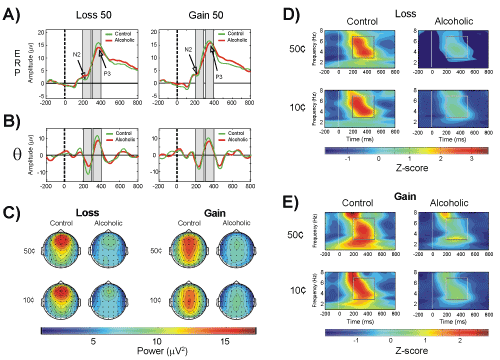
 |
| Figure 1: A) The grand-averaged ERP waveforms for Loss 50 and Gain 50 conditions; B) Theta bands during Loss 50 at FZ electrode and Gain 50 at CZ electrode are shown. The region of ORN (N2) and ORP (P3) peaks and the corresponding theta activity during the time window are shaded in gray color. There is a partial phasealignment of the theta activity corresponding to ORN (200-300 ms) and ORP (300-400 ms) components. Alcoholics showed decreased amplitude in theta (3–7 Hz) band more anteriorly (frontal) for the loss condition and more posteriorly (centro-parietal) for the gain condition. The dashed vertical line (at 0 ms) represents the onset of an outcome stimulus; C) Topographic maps of theta (3-7 Hz) power in control and alcoholic groups illustrating that the loss condition had an anterior topography and the gain condition had a posterior topography. Decreased theta band power in alcoholics in both conditions is illustrated; D) Time-frequency (TF) plots during the loss condition at the Fz electrode in the alcoholic and control groups; and E) TF plots during the gain condition at the Cz electrode. The square box inside TF plots marks the time-frequency region of interest, namely the time interval of 200–500 ms across the theta frequency range 3-7 Hz for analysis. The alcoholic group showed a significant reduction in theta power during each outcome condition. The color scale (in TF plots) represents the theta power in terms of Z-scores, which were computed from the overall data (representing all groups and conditions) and hence are comparable among the TF plots. |